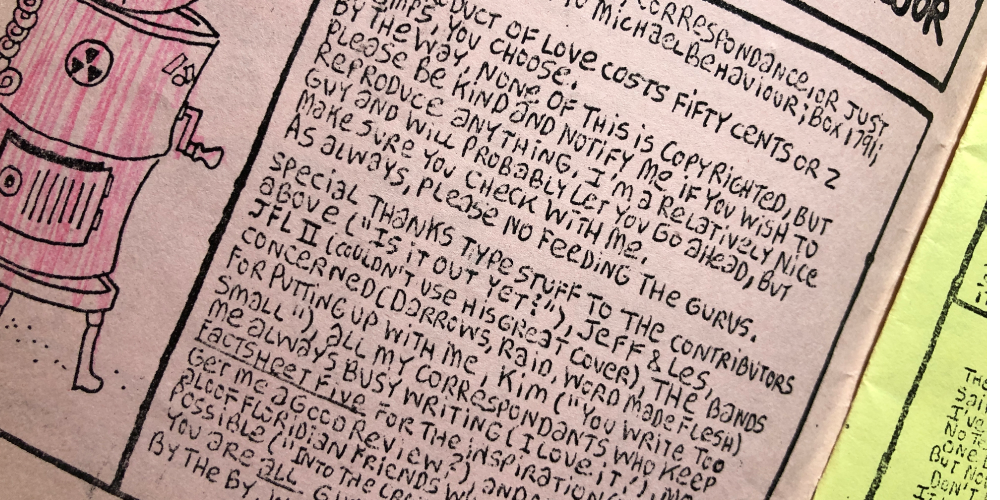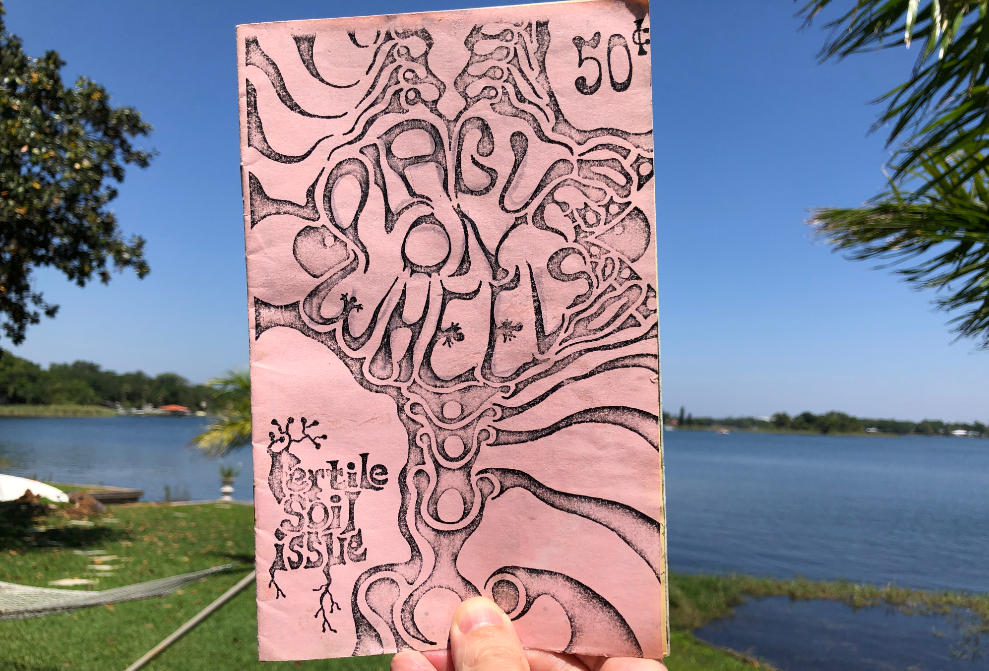In the late ’80s, I was heavily into zine culture. Isolated in Central Louisiana, I was an outcast kid into weird stuff, craving connections to an outside world of strangers. I can’t remember how I initially discovered zines and the related mail art community. I’m sure my love of DIY punk rock played a part.
Eventually, I obtained an issue of Factsheet Five. The mag inspired me to open a secret post office box, so all this unusual mail wouldn’t arrive at my parents’ house. After sending off several envelopes containing a few quarters, or postage compensation, or an enthusiastic letter, I was part of the zine scene. I was connecting and corresponding with like-minded weirdos across the world. Kind of like I still do today — but without sending out stamps.
Let’s get a couple of definitions out of the way. ‘Zine’ is short for ‘fanzine’ — a short-run, self-published, often obsessive, and sometimes free magazine made by (and for) a ‘fan’ of something. The first documented fanzine was created in the ’30s, probably by mimeograph. That original zine, like most zines in the mid-century, was focused on science fiction. Punk rock created another significant zine movement, and, in the ’90s, the format reached an apex with riot grrl zines.
But zines could be about anything. There were zines for collectors of you-name-it, anarchist zines, intimately personal scream-for-help zines, zines by moms about mom-life, conspiracy and UFO zines, comix zines, and on-and-on-and-on. One of the most unique and heartfelt zines I read at the time was Duplex Planet. Published by an employee of a nursing home, the zine featured interviews and updates with the residents as they arrived and (often sadly) departed. I’m pleasantly surprised to see that it’s still around. Duplex Planet showed the possibility of zines and self-publishing as a vehicle for a personal voice.
If you think this sounds a lot like blogging and email newsletters, then I’d say you’re not off course. I recently subscribed to Rusty Blazenhoff’s Electric Dreams email newsletter, and right there in the header, it’s called “An Inbox Zine.” Wherever you go, there you are.
I’m thinking about zines because of Factsheet Five. Factsheet Five was like a search engine for zines but it was also a zine. Hundreds of single paragraph reviews of zines filled its pages. And the reader was also given the zines’ addresses and how to get them (such as “.50 or two stamps”). There were also music etc. reviews and editorials from various zine luminaries. But you got this for the zine listings. It was a joy to go through all these zine descriptions and highlight the ones that created the most curiosity. From my perch in Tioga, Louisiana, these were pre-internet windows to the wider, weirder world.
One could receive Factsheet Five a few different ways — by sending three dollar bills and a couple of quarters to the editor, or by mailing something to review (music, your zine), or by contributing something (writing, artwork). I did all three of those throughout college to get my issues.
And here’s why Factsheet Five and zines are on my mind. Early this week, I was on Archive.org and thought, “I wonder if any old issues of Factsheet Five are archived here?” I did a quick search and discovered just under a dozen issues. I picked one from 1988 — as that’s the time I was most active in my zine-collecting — and flipped through the virtual pages. Amazing! I recalled when, to me, all of this was new and dangerous. I glimpsed some familiar names, including a few ‘pen-pals’ who I met through zine-trading. And then, to my surprise, I ran across a name I certainly recognized:

In 1988 I decided to publish my own zine. It was called Plague On Wheels. The name comes from the title of a fictitious book written by Kilgore Trout in Kurt Vonnegut’s Breakfast of Champions. It’s about aliens that look like automobiles. And ‘Michael Behaviour’ was my punk rock name. A lot of us young miscreant-wanna-bes had punk rock names in the ’80s.
The review refers to Plague On Wheels as a ‘pfanzine,’ which is zine slang for a music-oriented zine. The ‘p’ stands for ‘punk,’ but a pfanzine can be about any genre of music. My zine had a lot of music in it, including interviews with a few random bands that answered my letters. I doubt I even heard these bands beforehand — I wrote them to get free music in exchange for some ‘press.’ Luckily, none of their music was awful.

Plague On Wheels was handwritten, not typed. I didn’t have access to a photocopier (or the money to photocopy), so I had a pen-pal friend in Miami do it for me. I met this friend via Factsheet Five. He was a school teacher and could get free photocopies, but the quality was poor, and all the blacks faded in various tones of gray. Combined with the sometimes difficult to decipher handwriting, my distant friend and I agreed the flaws added a distinctive character.
My friend Flipper — also from Tioga — wrote the ‘How To Start a Radio Station’ piece. Now he has a book out through HarperCollins and regularly writes for established music magazines. I sent him this Factsheet Five review, and he told me that I was the first ‘publication’ to publish his writing.
Plague on Wheels. What a trip.

I feel like there’s something I can say here about zines and blogs and newsletters. I should pull out my recurring theme of ‘the way we use new technologies can’t escape tradition.’ It does feel like I’ve been doing this a while. Running across a blog with an exciting point of view is similar to finding a cool zine on Factsheet Five. It just seems, with zines, the freak flag flies a little higher.
Zines are still around. And blogs and newsletters are resurgent. As long as singular voices are looking to connect — to find the others — we’ll have zines and blogs and all these things. And maybe our current state of isolation, this self-quarantining, has me thinking about how vital these voices are when we can’t seek each other out in person. Many of us need the weird little windows to the outside world, especially when those worlds seem cut off from us.
This post was adapted from Ringo Dreams of Lawn Care, a weekly newsletter loosely about music-making, music-listening, and how technology changes the culture around those things. Click here to check out the latest issue and subscribe.
